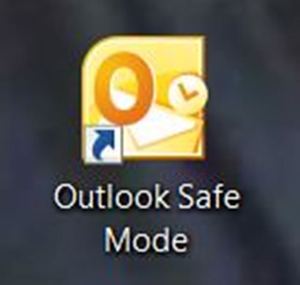When Outlook encounters a problem, you may see a prompt asking if you want to work in Outlook safe mode. If you do not see the prompt window but would still like to start Outlook in safe mode, you can start it manually. How you start in safe mode depends on the version of Windows you are using, and how you troubleshoot in safe mode depends on the version of Outlook you are using.
What is Safe Mode?
In automated safe mode, Outlook either disables the area in which it has detected a problem, such as add-ins. Once you start in Outlook safe mode, you can view a list of the disabled items and enable them one at a time to try to discover and resolve the problem.
From the Desktop, Taskbar or Start menu
If you have Outlook saved on your computer desktop, you can start it in safe mode from the desktop by pressing and holding the Ctrl key while clicking on the desktop icon. The same method works when clicking a taskbar or Quick Launch Toolbar icon as well as the program in the Start menu. Simply press and hold Ctrl and then click on the Outlook icon. As Outlook starts, it displays a prompt asking whether you want to start the program in safe mode. Click Yes to continue.
Start Menu Search
If you are using Windows Vista, Windows 7 or Windows 8, you can use a Start Menu shortcut to start Outlook in safe mode. Simply click Start and type outlook.exe /safe into the search box. Press Enter or click on the outlook.exe /safe option that appears in the list of search results under Programs. Outlook starts automatically in safe mode.
Create a Shortcut
You can create a desktop shortcut that will automatically open Outlook in safe mode, which is convenient if you use this feature frequently.
First, find the file location of your Outlook application. Click the Start button and type Outlook.exe into the search box. Right-click Outlook.exe in the list of results under Programs and choose Open File Location. Click inside of the address bar to select the file location and press Ctrl-C to copy it.
Next, open the Create Shortcut Wizard. To do so, right-click any unused area on your desktop, point to New and select Shortcut. Click inside the Type the Location of the Item box and press Ctrl-V to paste the file location. Type outlook.exe at the end of the file location if it does not appear, and enclose the location in quotation marks, such as “C:Program Files (x86)Microsoft OfficeOffice14OUTLOOK.EXE”. Enter a space after the file location and then type /safe, so that it appears similar to this: “C:Program Files (x86)Microsoft OfficeOffice14OUTLOOK.EXE” /safe
Click Next and enter a name for the shortcut, such as Outlook Safe Mode. Click Finish to create the new desktop shortcut.
Once you have opened Outlook in safe mode, you can begin troubleshooting.





